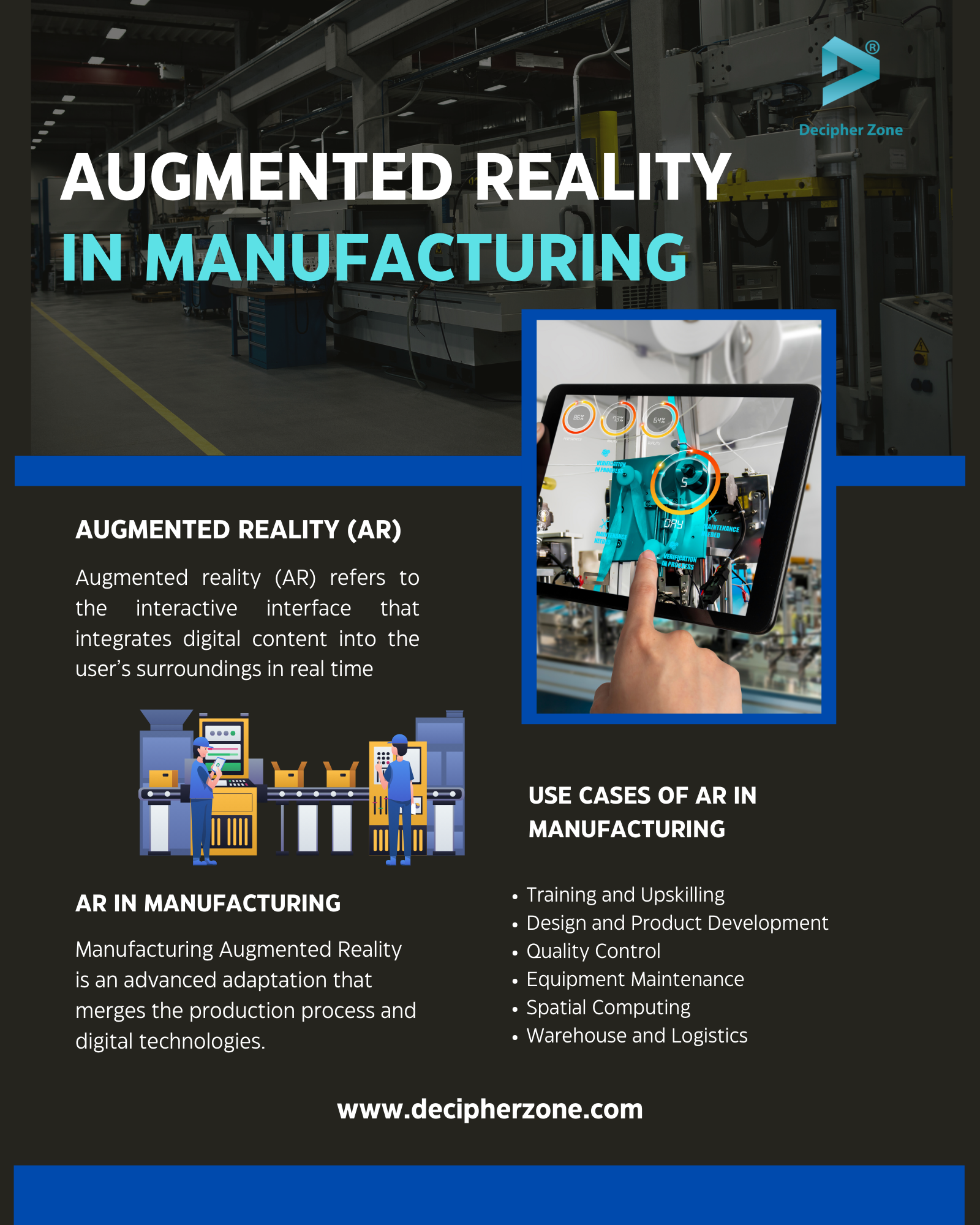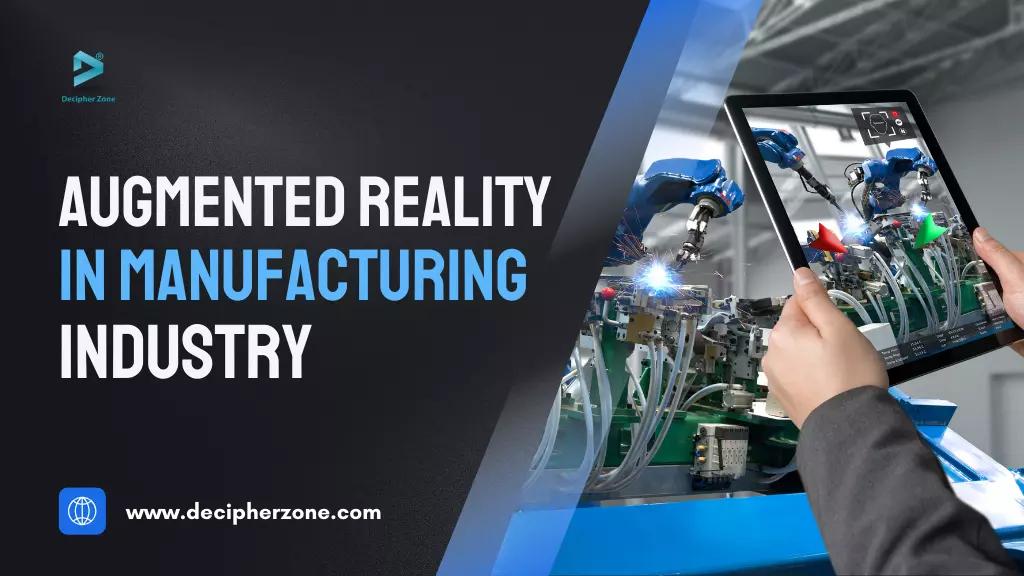Top Uses and benefits of Augmented Reality in Manufacturing. Augmented reality is no longer limited to games and entertainment, it has slowly garnered its importance for its usage across industries for different purposes. It is now a groundbreaking technology transforming how industries operate, especially manufacturing. If reports are to be believed, the global market size of AR and VR in manufacturing will hit somewhere around $74.1 billion by growing at a CAGR of 24.62% between 2023-2032.
But what makes AR crucial for manufacturing? In this article, we will explore everything you need to know about AR in manufacturing and its use cases. So, without further ado, let’s begin!
Defining Augmented Reality
Augmented reality (AR) refers to the interactive interface that integrates digital content into the user’s surroundings in real-time. This content can have multiple sensory modalities like olfactory, auditory, haptic, visual, and somatosensory. Unlike virtual reality which is entirely virtual, AR uses a real-world environment where users can control their presence.
In augmented reality, computer hardware and software like screens, projectors, consoles, and apps are leveraged to bring digital content into the real world. AR can be used for multiple purposes including but not limited to product visualization, gaming, marketing campaigns, education, interior designing, industrial manufacturing, and medical training.
This brings us to our next point…
Read: Boost Your Business Using Augmented and Virtual Reality
How AR is used in Manufacturing?
Manufacturing Augmented Reality is an advanced adaptation that merges the production process and digital technologies. By combining computer-generated content such as data, graphs, images, and other interactive elements, AR creates an enhanced reality that reduces the need for manual labor and increases productivity, visibility, and control over the manufacturing process.
Some of the popular manufacturing industries that use AR in their processes include automotive, aerospace & defense, electronics, healthcare, logistics, and retail.
A few use cases that show how augmented reality improves manufacturing operations are as follows:
Training and Upskilling
AR can help employees engage in realistic simulations to gain hands-on experience for understanding complex concepts with ease. It makes learning interesting and engaging for the new hires so that they can become independently productive.
With augmented reality comes on-demand training and upskilling experiences that can be accessed by employees from anywhere to learn and practice important aspects of work, used equipment, safety hazards, etc. This leads to reduced operational costs and concentrated, flexible curriculums during onboarding.
Design and Product Development
Augmented reality along with digital twins and the IoT helps product designers to bring products to life, test them, and adjust the prototype before they are physically designed and manufactured for the target market.
Quality Control
Ensuring the manufactured product quality through regular inspection and verification is extremely important in the manufacturing industry. Augmented Reality (AR) can help workers gain insights into the machines and equipment they are working with.
With the aid of quick inspection through work instructions, 3D vision cameras, and machine learning, AR can detect errors and potential issues, making the inspection process faster and more efficient.
Equipment Maintenance
To keep the machinery and equipment running smoothly, it’s necessary to conduct regular examinations. These inspections allow businesses to ensure the frontline worker’s safety and efficiency.
AR helps enterprises improve equipment maintenance by providing contextualized real-time information to the technician. Through AR headset, technicians can access and apply detailed instructions while removing trails and errors as well as reducing downtime that comes with machine maintenance operations.
Read: Metaverse Application Development
Spatial Computing
AR has been instrumental in bringing spatial computing to life. AR works as a tool to visualize data in the real world, creating engaging interactions with visual objects. A manufacturer uses AR to learn and understand a particular object or material by visualizing its density, volume, lateral surfaces, hardness, and other properties in three-dimensional space using an AR headset.
AR also helps in previewing the prototype of a product and how it would look when developed to detect any potential flaws that can be addressed in the production phase.
Warehouse and Logistics
Manufacturing workers can also use AR-based headsets, glasses, and other hardware to organize equipment and goods in warehouses that need to be managed or moved. It also allows workers to find the required items among millions of other stored products, allowing them to quickly scan, retrieve, and upload items needed on the loading dock.

Benefits of Augmented Reality in Manufacturing
There are several benefits of integrating augmented reality in manufacturing. Some of the key advantages are as follows:
-
AR makes it easier to access information whenever required by workers. This in return improves the onboarding process for new hires, helping them navigate through new processes and products with ease.
-
It also provides floor workers with contextual guidance to make production processes sleek. AR alerts about the errors in real-time, allowing quick addressing of the potential issues that might later affect the quality of the product.
-
Incorporating augmented reality in the design phase enables product designers to adapt to continuously changing customer needs leading to shorter product development lifecycles and reduced prototyping time and cost.
-
Utilizing AR, manufacturing companies can not only replace the function and work of real equipment or people but also create an experimental learning environment that’s safe from risks.
-
The instructions offered by AR also reduce errors while inspecting, assembling, and maintaining machinery and products to minimize waste and rework.
Conclusion
If you are still comprehending whether the use cases of AR in manufacturing are real or fiction, let’s inform you about some of the popular brands that are using it to improve quality, safety, and efficiency in their operations. These brands include ANDRITZ Ritz, TATA, Martin-Baker, Ford, Porsche, Cisco, Lockheed Martin, Dassault Systemes, Seimens AG, ThyssenKrupp, Samsung, and Jabil Circuit.
Read: Improve Learning and Training Process in Manufacturing
Needless to say, Augmented reality is developing and becoming a vital part of the manufacturing industry at a rapid pace. Intelligent display tech, intelligent interaction tech, artificial intelligence, machine learning, simultaneous location and mapping (SLAM), image processing, and projection, depth tracking, and IoT are some of the major technologies behind the success of augmented reality.
Read: Top Advanced Mobile App Features
In conclusion, if you are a manufacturer wanting to improve the quality and productivity of your workplace, then hire developers to build AR software to manage and control AR-enabled hardware, then get in touch with our experts today!

